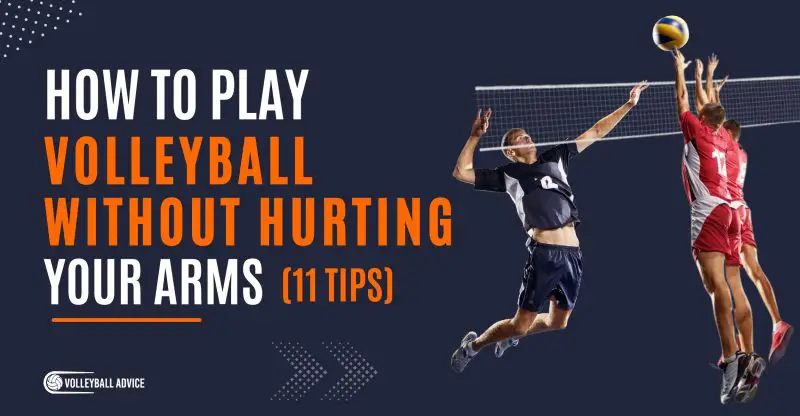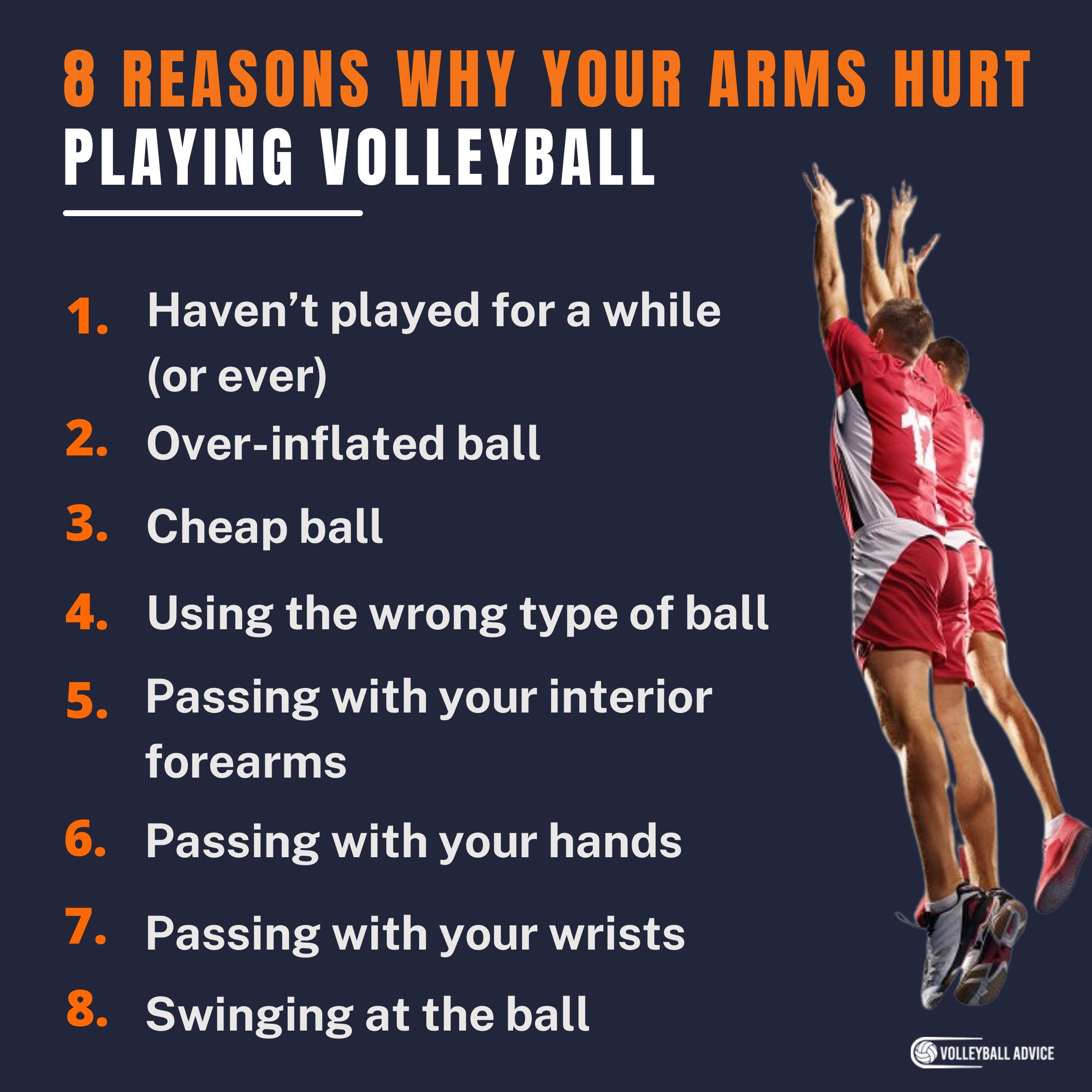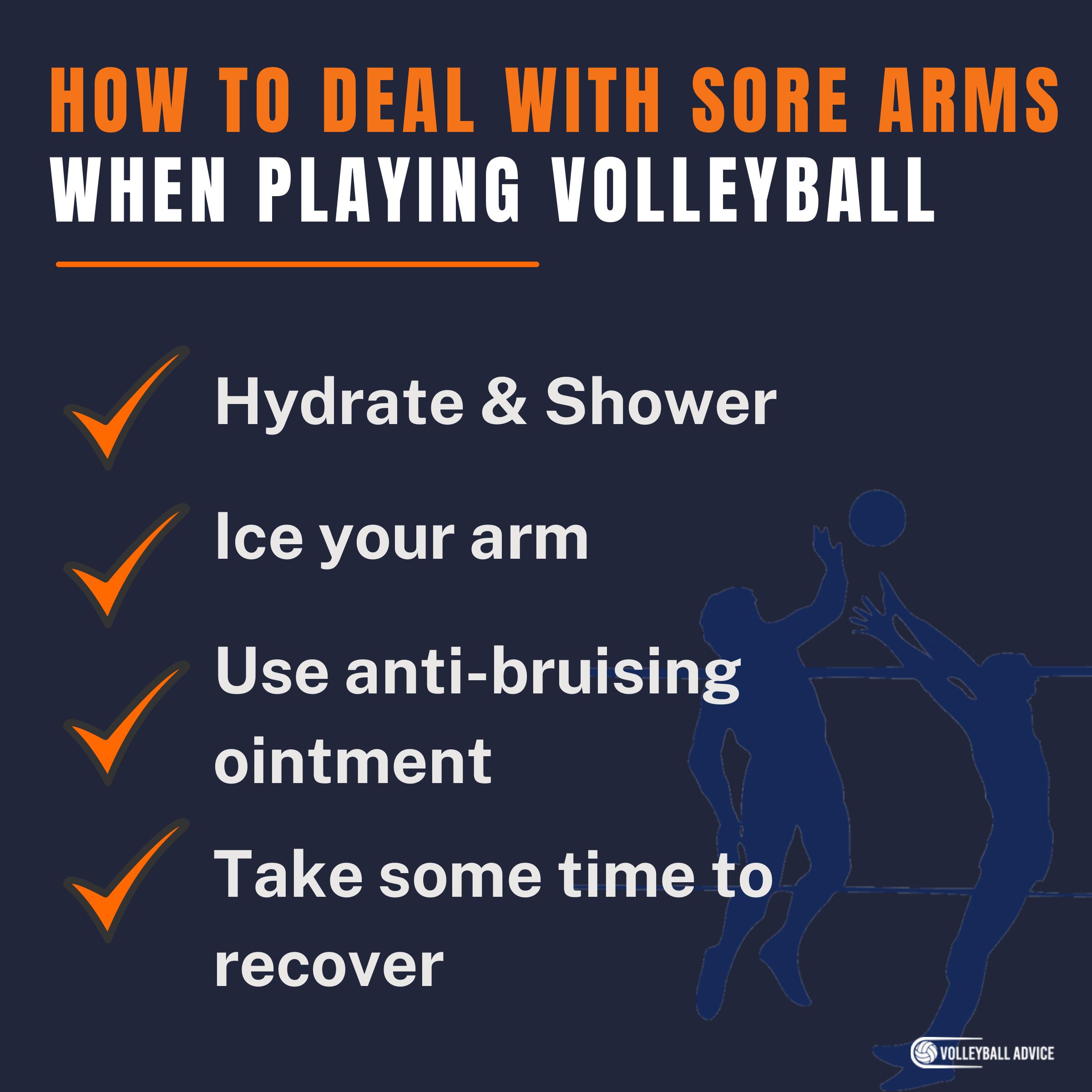How To Play Volleyball Without Hurting Your Arms (11 Tips)
For all of its fun, volleyball – like any performance sport – has its share of pains along with the games, and the arms are often the first to suffer.
Sore volleyball arms have been a trope for years when people complain about the sport or to beg out of practice. While there is a good deal of truth to the matter, it has been entirely blown out of proportion for what it really is. When played correctly, there is little to no reason that playing volleyball should hurt your arms.
So, how do you play volleyball without hurting your arms? You play volleyball without hurting your arms by using proper passing technique, playing with a properly pumped ball of FIVB quality (Fédération Internationale de Volleyball), and warming up before you play. Wearing arm sleeves or other padding equipment can also aid in reducing pain and inflammation.
Today, I’m going to be discussing everything related to arm pain in volleyball. By the end of this article, you should be able to:
- Identify why your arms hurt
- Understand how to avoid hurting yourself while playing volleyball
- Know some products to help reduce pain
- Help yourself and others recover after a practice
Is It Normal For Your Arms To Hurt Playing Volleyball?
Yes, it’s normal for your arms to hurt when you begin playing volleyball, but this is nothing to worry about and will fade quickly.
At more advanced levels, you should already understand the difference between good pain and bad pain for passing, and while you may pass much harder-driven balls hit at you they’re much less likely to actually hurt you.
No matter the level of play, the stinging and redness should typically disappear within an hour of practice, although in some cases it might leave bruises. These are very superficial and though uncommon, are more known to occur when playing with poor form – specifically when passing on the full forearm.
8 Reasons Why Your Arms Hurt Playing Volleyball
The top 8 reasons your arms hurt while playing volleyball are:
- Haven’t played for a while (or ever)
- Over-inflated ball
- Cheap ball
- Using the wrong type of ball
- Passing with your interior forearms
- Passing with your hands
- Passing with your wrists
- Swinging at the ball
Haven’t Played For a While (or ever)
The most common reason why your arms hurt while playing volleyball is because you haven’t played in awhile – or ever – and have not developed the toughness that allows a diminishment of pain while contacting the ball, either for passing, hitting, blocking, or serving.
This usually happens when coming back over the summer to find that your arms hurt for a week of practice. Keep playing but take it easy on your tender skin, and the pain will fade and soon disappear as continuous stress toughens the skin and lowers sensitivity in the pain-nerve endings in the region
The time range differs from person to person, but most people find that it’s gone within a few days. For others, the longest it lingers is a week. After that, you shouldn’t have any problems until you stop playing or play at a higher level.
Over-Inflated Ball
The next most common reason your arms hurt while playing volleyball is having an over-inflated ball where it feels like a rock ‒ hard, heavy, and able to do a lot of damage.
Passing one of these might cause discomfort and swelling with repetition – although it will also build immunity to it over time.
Cheap Ball
Similar to using an over-inflated ball, cheap or off-brand volleyballs are usually made with sub-par material that aren’t designed to be as kind to its players as officially recognized brands are. This has the potential to cause irritation and – if over-inflated – swelling in the arms.
To avoid this, purchase one of the officially recognized balls by one of the volleyball national governing bodies, such as FIVB.
I’ve reviewed most of these volleyballs, which you can find in my article 10 Best Volleyballs (Indoor, Outdoor, Beach, Backyard, Pool).
Using the Wrong Type of Ball
This mistake is commonly the cause of arm pain for school kids who are just looking to have a good time.
Unfortunately, using a soccer ball, football, basketball, or even kickball for volleyball can be harmful to the skin and cause pain – especially if spiking is involved. Once again, this can help condition your arms to endure tougher conditions, but if you wish to avoid this altogether just don’t use these balls.
Volleyballs are specifically designed to both bounce well and be kind to the players who use them, and should be the only balls used for the sport. If you find the normal ball too inaccessible price-wise or simply not suitable for your family or team, there are a range of volleyball-kind balls for the pool, beach, and even specially-tailored learning balls that are both larger and slightly deflated to help kids develop.
Here’s my top volleyball for kids recommendation.
Passing With Your Interior Forearms
Now we move onto technical mistakes and the specific parts of the arm that hurt when used improperly.
To recap: The ball should be passed on the forearms with the hands locked into a passing frame in front of you, with your shoulders shrugged up and forward, bringing your elbows together.
Passing with your interior forearms – the fleshy bulk – can lead to arm pain.
A proper volleyball passing platform hides the majority of the interior forearms and exposes the sides of them instead, creating a nice flat platform to pass with. It’s almost impossible to pass with this part of your body unless you drop your platform however, so maintaining good form will protect you here.
Related Article: 7 Types of Passing In Volleyball (Detailed Breakdown)
Passing With Your Hands
Passing with your hands is a tricky one, and lots of high school players I knew actually preferred to pass the ball from here until they learned proper technique. They would take the pass on their clasped thumbs, pushing their fingers together without gaining proper control of the pass.
To avoid pain in your hands from passing, take an extra step forward through the ball and catch it on your forearms, where you have not only more surface area to contact the ball with but a stronger frame to receive it on. This will help you avoid pain in your hands.
Passing With Your Wrists
Passing with your wrists is what a lot of players are told, but that is incorrect and has led to a lot of wrist pain as the ball impacts their wrist joint over and over again, causing swelling.
This is not ideal for many reasons besides the pain, the biggest of which is that of the entire passing platform, passing with the wrists means receiving the ball on the thinnest portion of your platform, and therefore less stable.
Swinging At the Ball
Last but not least, swinging at the ball may be a cause of arm pain: either of stinging redness in the forearms, which comes from the increased impact force you generate through swinging, or by over-extending your shoulders or elbows in unnatural ways.
Our passing platform exists for many reasons, the foremost of which is to keep you – the passer – safe. Not only from the ball, but from yourself and others, any of whom may be flailing wildly towards the ball if technique didn’t exist.
Avoid arm pain by not swinging at the ball, and trust your platform to do the work for you.
11 Tips To Avoid Arm Pain When Playing Volleyball
- Learn and practice proper technique for passing, demonstrating a solid platform and shrugged shoulders.
- Avoid passing with the interior of your forearms, hands, or wrists: these are the weakest parts of your arms, and the most susceptible to pain.
- Use a quality volleyball that has been regulated by a national governing body such as the FIVB.
- Make sure the volleyball is inflated to the correct PSI: this should be listed either around its valve or can be found online on the FIVB site.
- Start light and build to more serious drills – peppering is a good way to begin, as it slowly warms up your entire body as you play.
- Remember to stretch and hydrate, giving your body lots of time to wake up and be ready for the workout. This will make your body less susceptible to injury.
- Build forearm muscle. As you pass with your forearms, building additional forearm muscle will give you a larger surface area to pass but also protect your nerve endings from damage.
- Wear arm sleeves. Sleeves can add an additional layer of padding that helps decrease arm pain from passing and leave your skin unblemished if you are sensitive or bruise easily. Several of my women’s team colleagues wear these during practice, and they work!
- Play a position that doesn’t do a lot of passing if you need to give your arms time to recover. Positions like middle blocker, setter, and opposite hitter play lower defense roles and can give you an opportunity to still play.
- Get enough rest. Especially with back to back training days, recovery is important. Sleep is when you build muscle and your body goes to work repairing the damage from the day before. Food gives your body the building blocks to do that. If you’re not taking care of your body, you’re setting yourself up for failure through preventable injuries and cumulative pain.
- Deal with it. At the end of the day, forearm pain is a part of learning how to play volleyball, and it’s by far the least intense thing we do out there. If you’re lucky, you’ll never experience it ever; some of my friends are like that. But for the rest of us, it’s a ritual of returning to play and is transitory; it will be gone within a week.
How To Deal With Sore Arms When Playing Volleyball
Recovery is important, whether you were prepared for your arms to hurt or not, so here’s a section dedicated to helping you feel better.
Hydrate & Shower
First, hydrate and shower. Your body just sweat a lot, and it needs to recover what it lost.
Ice
Next, ice your arm, ten minutes on ten minutes off for an hour. This will sting at first but eventually numb your arm and help reduce the swelling. Give it thirty minutes and if the pain hasn’t diminished, repeat the ice treatment. Wait and repeat as necessary.
Use Anti-Bruising Ointment
If you have any anti-bruising ointment, go ahead and apply that to the area. You may also bind the area with gauze for additional padding, although neither of these steps are strictly necessary.
My top recommendation is Heladerm Cream (click to check price on Amazon). It’s made with vitamin K, arnica oil, and natural notoginseng, all of which have been shown to help with bruising.
![]()
![]() Take Some Time To Recover
Take Some Time To Recover
Lastly, bundle up in your favorite soft pajamas, take a seat on your comfiest couch, and turn on the next season of your favorite show. Rest is important for recovery, and now that you’ve done all that you can it’s time to let your body take over.
The pain should disappear before you sleep, unless you’ve had an advanced passing session or two. If the redness hasn’t vanished by morning, rinse it gently under hot water in the shower to help the pooled blood dissipate. It’s possible that you may have a bruise, but that’s ok! It too will disappear, but if the pain is too much just ask your coach to just set or toss for a day.
Ultimately, although the pain sucks it will vanish, leaving you standing stronger than ever.
Do Volleyball Arm Sleeves Help With Arm Pain?
Yes, proper volleyball arm sleeves will help with arm pain.
My personal and Premier-league level recommendation are the Mizuno Arm Sleeves (check today’s price on Amazon).
They are stylish and awesome, offering compression qualities as well as a sufficient passing barrier for your forearms. It’s also used by the US national team!
Final Thoughts: What Happens If The Pain Persists When Playing?
If the pain persists when playing and you find it too intense to play through, I recommend asking the coach to sit out or help toss the balls while your arms recover. It’s nothing to feel ashamed about: you were working harder than your body had ever felt before, and that’s awesome.
Arm pain from passing might hurt a lot, but it’s nothing serious: you will be fine. Follow my icing routine to help with recovery (ice ten minutes on and ten minutes off for an hour) and remember – the faster you get that ice on there the faster it begins to heal!
It’s normal to feel raw and bruised for a couple days to a week after starting playing, but make sure to get enough rest and eat enough and you’ll be right as rain in no time!
About The Author
Ailan Samuel is a writer and athlete who has played volleyball at the university, club, and national level since 2012. He has competed successfully in both beach and indoor competitions, resulting in four silver and two gold medals, and was awarded the Half-Blue while playing in Scotland. He received his MA in English and Medieval History from the University of St Andrews, Scotland, and is currently studying for his MA in Publishing and Creative Writing at Bournemouth University.



